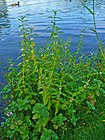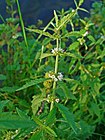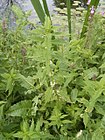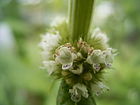Note: This is a project under development. The articles on this wiki are just being initiated and broadly incomplete. You can Help creating new pages.
Difference between revisions of "Lycopus europaeus - Gypsywort"
(→List of Ayurvedic medicine in which the herb is used) |
(→References) |
||
| Line 71: | Line 71: | ||
<references> | <references> | ||
| − | <ref name="chemical composition">[https://www.herbcottage.com.au/gypsywort.html | + | <ref name="chemical composition">[https://www.herbcottage.com.au/gypsywort.html Constituents]</ref> |
| − | <ref name="Leaf">[http://www.luontoportti.com/suomi/en/kukkakasvit/gipsywort | + | <ref name="Leaf">[http://www.luontoportti.com/suomi/en/kukkakasvit/gipsywort Plant description]</ref> |
| − | <ref name="How to plant/cultivate">[https://www.pfaf.org/user/Plant.aspx?LatinName=Lycopus+europaeus | + | <ref name="How to plant/cultivate">[https://www.pfaf.org/user/Plant.aspx?LatinName=Lycopus+europaeus Cultivation details]</ref> |
</references> | </references> | ||
Revision as of 07:22, 21 September 2019
Lycopus europaeus is a perennial plant in the Lycopus genus native to Europe and Asia, and naturalized elsewhere.
Contents
- 1 Uses
- 2 Parts Used
- 3 Chemical Composition
- 4 Common names
- 5 Properties
- 6 Habit
- 7 Identification
- 8 List of Ayurvedic medicine in which the herb is used
- 9 Where to get the saplings
- 10 Mode of Propagation
- 11 How to plant/cultivate
- 12 Commonly seen growing in areas
- 13 Photo Gallery
- 14 References
- 15 External Links
Uses
Gout, Cuts, Overactive thyroid, Liver disorders, Skin eruptions, Blotches, Pimples, Diarrhea, Sore throats
Parts Used
Chemical Composition
flavonoids, tannins, phenolic acid derivatives such as rosmarinic acid, a bitter essential oil and manganese, fluoride and other elements[1]
Common names
| Language | Common name |
|---|---|
| Kannada | |
| Hindi | |
| Malayalam | |
| Tamil | |
| Telugu | |
| Marathi | NA |
| Gujarathi | NA |
| Punjabi | NA |
| Kashmiri | NA |
| Sanskrit | |
| English | Gypsywort |
Properties
Reference: Dravya - Substance, Rasa - Taste, Guna - Qualities, Veerya - Potency, Vipaka - Post-digesion effect, Karma - Pharmacological activity, Prabhava - Therepeutics.
Dravya
Rasa
Guna
Veerya
Vipaka
Karma
Prabhava
Habit
Identification
Leaf
| Kind | Shape | Feature |
|---|---|---|
| Simple | Opposite | Stalkless–short-stalked. Leaf blade lanceolate–narrowly ovate, hairy, margin large-toothed–pinnately lobed. |
Flower
| Type | Size | Color and composition | Stamen | More information |
|---|---|---|---|---|
| Unisexual | 4 mm | Yellow | 2 | Corolla almost regular (actinomorphic), with white and red dots, approx |
Fruit
| Type | Size | Mass | Appearance | Seeds | More information |
|---|---|---|---|---|---|
| schizocarp | 7–10 mm | 4-parted schizocarp. Mericarps quadrangular, slightly flat, yellowish brown, with oil-secreting glands | many | {{{6}}} |
Other features
List of Ayurvedic medicine in which the herb is used
Where to get the saplings
Mode of Propagation
How to plant/cultivate
Tolerates most soil types so long as they are wet. Grows well in shallow water.[3]
Commonly seen growing in areas
Europe and Asia, Marshlands, Wetlands.
Photo Gallery
References
External Links
https://www.herbal-supplement-resource.com/bugleweed-herb.html Therapeutic Uses, Benefits and Claims of Bugleweed
- Ayurvedic Herbs known to be helpful to treat Gout
- Ayurvedic Herbs known to be helpful to treat Cuts
- Ayurvedic Herbs known to be helpful to treat Overactive thyroid
- Ayurvedic Herbs known to be helpful to treat Liver disorders
- Ayurvedic Herbs known to be helpful to treat Skin eruptions
- Ayurvedic Herbs known to be helpful to treat Blotches
- Ayurvedic Herbs known to be helpful to treat Pimples
- Ayurvedic Herbs known to be helpful to treat Diarrhea
- Ayurvedic Herbs known to be helpful to treat Sore throats
- Herbs with Leaves used in medicine
- Herbs with common name in English
- Habit - Herb
- Index of Plants which can be propagated by Seeds
- Index of Plants which can be propagated by Cuttings
- Herbs that are commonly seen in the region of Europe and Asia
- Herbs that are commonly seen in the region of Marshlands
- Herbs that are commonly seen in the region of Wetlands
- Herbs
- Lamiaceae







